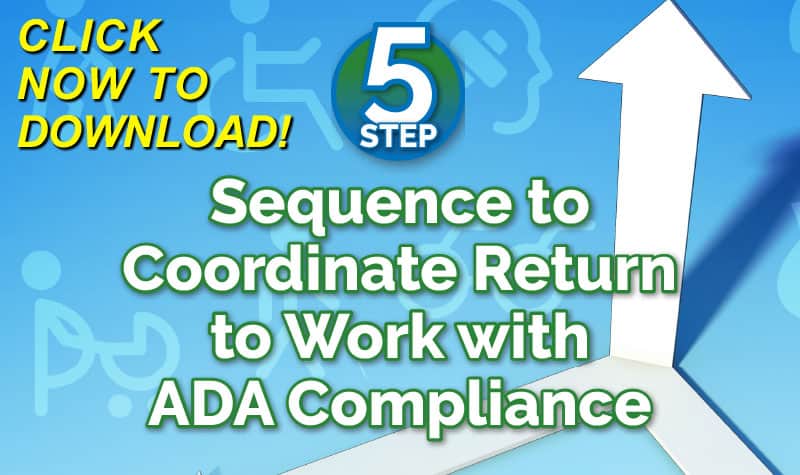
Find below the responses to the questions related to the Interactive Process given by Aaron Konopasky, Senior Attorney Advisor, US Equal Employment Opportunity Commission, and Michael Stack, Risk Consultant, Co-Author Your Ultimate Guide to Mastering Workers Comp Costs
Click Link to Access Free PDF Download
“5-Step Sequence to Coordinate Return-to-Work with ADA Compliance”
A follow-training on How to Coordinate Return to Work with ADA Compliance initiated additional questions:
- ADA – If light duty cannot be accommodated, should FMLA run concurrently?
- ADA – Do All Work Comp Injuries Fall Under the Americans with Disabilities Act Amendments Act (ADAAA)?
- ADA – Is it against the law not to hire a person with a disability for a physical position?
If someone is pregnant and on light duty, but light duty is not available, can the employer terminate the employment?
The inclusion of pregnancy makes this much more complicated. The Supreme Court just decided a case called Young v. UPS that addresses this issue, and it’s complicated enough that I won’t address it here.
So let’s assume that someone is put on light duty because of a disability. (A pregnancy-related illness or injury can be a disability too. It only gets more complicated if the pregnant person needs light duty based only on the fact that she is pregnant, without any associated medical condition.)
If no light duty is available, I would first make sure that the employee really can’t do his or her normal job, even with a reasonable accommodation. (Could he or she do the regular job on an alternative schedule? With special equipment? From home? …) Sometimes doctors aren’t thinking about the possibility of reasonable accommodation when they decide whether someone can return to “full duty.”
If there really is no way that the employee can do her original job, the employee should be allowed to use accrued leave or FMLA leave, if any. (Employers with 50 or more employees are required to provide unpaid leave for up to 12 weeks under FMLA, provided that certain other requirements are met.)
If the employee has no accrued leave or FMLA leave available, but additional unpaid leave would allow the employee to return eventually, and would not cause significant difficulty or expense to the employer, then the leave should be provided as a reasonable accommodation.
If leave would not allow the person return eventually, or if it would cause significant difficulty or expense, then the employer needs to consider reassignment. If there is a vacant position, and the employee is qualified, and reassignment would not cause significant difficulty or expense, then the reassignment must be provided as a reasonable accommodation.
If none of the above options are available, then the person can be terminated.
[Publishers note: The above statements refer specifically to ADA federal law. It is not recommended in workers’ compensation to terminate an employee in the middle of a workers’ compensation claim as it contributes to high claim costs. Human resources issues are best kept separate from workers’ compensation.]
If we have a transitional duty program, are we in jeopardy of being sued by employees if we terminate them because we cannot provide a reasonable accommodation?
Whether you have a transitional work program or not, employers must provide reasonable accommodations that allow an employee to do his or her regular job, unless doing so would cause significant difficulty or expense. If the employer fails to do this, then the employee could sue.
So, before terminating someone, the employer must ask whether a reasonable accommodation would allow the person to accomplish what the job requires. If so, then the employer has to provide the accommodation. (The employer is not required to offer additional transitional work, which is different from a reasonable accommodation, but it could choose to do so as a workers comp cost containment best practice).
If an on-the-job-accommodation wouldn’t help, or would cause significant difficulty or expense, the employer would need to consider unpaid leave as a possible accommodation (Employers with greater than 50 employees are required to provide up to 12 weeks of unpaid leave under FMLA). If additional leave would allow the person to return eventually, and would not cause significant difficulty or expense, then the employer should provide the leave.
If unpaid leave would not allow the person to return eventually, or would cause significant difficulty or expense, then the employer should consider reassignment to a vacant position for which the employee is qualified (if one exists), as a reasonable accommodation. If none of those options are available, then the employee can be terminated.
What if an employee, during the interactive process, says no, he or she is not aware of a reasonable accommodation?
If an employee who is having trouble at work because of a disability can’t think of an accommodation that would allow him/her to remain on full duty, the next step is to look for possible solutions together. Calling the Job Accommodation Network, for example, might be helpful. There is no cost.
If, after searching for an accommodation, you decide that there just isn’t one that allows the person to work at full capacity, then you would need to explore the possibility of leave or reduced work responsibilities. If the person has accrued leave available, or is eligible for FMLA leave, then he or she should be allowed to use it. (Employers with 50 or more employees are required to provide up to 12 weeks leave under FMLA, provided that certain other requirements are met.)
If the employee has no accrued leave or FMLA leave available (because the employer has less than 50 employees, because it has already been used, or for any other reason), unpaid leave could be a reasonable accommodation if it would allow the person to eventually return and would not cause undue hardship. The employer also has the option of voluntarily offering a transitional work assignment.
If the employee is expected to never be able to return to his or her original job, then the employer needs to consider reassignment. If there is a vacant position, and the employee is qualified, and reassignment would not cause significant difficulty or expense, then the reassignment must be provided as a reasonable accommodation.
What about union contracts that stipulate “no light duty?”
The ideas of light duty and reasonable accommodation need to be kept separate. The union contract could not be interpreted to mean “no reasonable accommodations,” because then the contract would violate federal law. What this means is that, if an employee has a disability, and can’t do his or her normal job, the employer still needs to figure out whether a reasonable accommodation would allow the person to do the essential functions of the job without causing significant difficulty or expense. The employer would also need to consider leave and reassignment as reasonable accommodations, when appropriate.
The contract is addressing a different sort of solution: creating a temporary new job for the person that isn’t as physically demanding. It’s the difference between finding a different way for the employee to meet the usual demands of his or her job, versus giving the employee a different job temporarily.
What about employees in transitional duty that are literally counting paper clips or just sitting in a break room?
[Publisher’s note: What you are referring to is a very ineffective return to work program as counting paper clips is not productive for the employee or employer. This practice occurs when the employer has not properly prepared for Return to Work. A more effective strategy is to create a transitional duty job bank prior to injury that contains a list of productive light duty positions. Ask supervisors to create a ‘wish list’ of tasks they need completed, but have not had time to complete. Another strategy is to create a Job Demands Library working with an expert in physical therapy or ergonomics to more easily place employees in positions that can accommodate their physical restrictions.]
The ADA does not require the employer to provide transitional duty where the employee cannot meet the usual demands. So, in this case, the counting paper clips could not be required by the ADA.
However, the employer should determine whether a reasonable accommodation would allow the person to return to his or her regular job. If so, the employer is required to provide it unless it would cause significant difficulty or expense. If not, the employer would also need to consider leave and reassignment as reasonable accommodations, when appropriate.
Author:

Dr. Konopasky joined EEOC after receiving his J.D. from Stanford Law School. Prior to law school, he received his Ph.D. in philosophy from Princeton University, and served as an adjunct professor of philosophy at Rutgers University, Tulane University, and the University of New Orleans.
Author:

Contact: mstack@reduceyourworkerscomp.com.










I was injured at work,I’m currently seeing occupational therapist,my company says it has no light duty accommodation, I’m being given the run around in regards to lost wages,temporary disability payment.
Hello after working on light duty I’ve had a few problems with my dept manager so I filed a internal complaint against him a few later they gave my notice I was going back to 12 hour night shift so I mentioned how am I going to do work conditioning being that my shift would be 7pm-7am then conditioning 7am to11am there response was I can do it on my own tine is that legal
Also got put on light duty. My boss refuses to give me light duty even though there is light duty. This is a second time of me getting hurt at work. This point not sure what to do because I do not want to get hurt a third time.
What if driving was a requirement of your and you have epilepsy and the doctor was you can’t drive for 6 months and your job does not offer light duty or long enough time off on leave?
I was placed on light duty at work and the company fired me and turned down my unemployment benefits. Is that fair or right?
I got hurts at work my employer put me to work as a light duty but, they giving me the schedule that im not prepared for. What should i do?